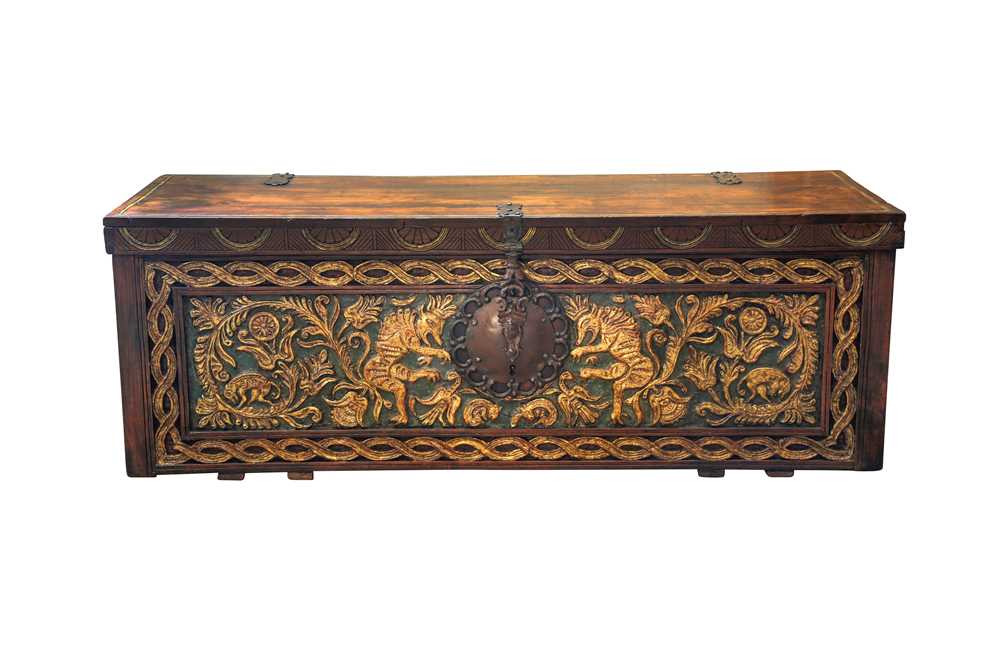(Islamic & Indian Art, 29th October 2020) A LARGE CARVED AND GILT HARDWOOD MARRIAGE CHEST Possibly Northern Greece or Balkans, Ottoman Western Provinces, 18th century A LARGE CARVED AND GILT HARDWOOD MARRIAGE CHEST Possibly Northern Greece or Balkans, Ottoman Western Provinces, 18th century Of rectangular shape, resting on a flat base, the lid plain with a simple gold frame around the borders, the front panel carved in relief and gilt, populated with mythical creatures and lush scrolls of flowers and foliage, the two mythical creatures standing near the keylock wearing a crown, reminiscent of rampant wolves and lions found in Balkan folklore paintings and decorations, the composition framed within a gilt plaited fretwork band, the sides with similar border decorations and curved bronze handles, the edge of the lid carved with gilt medallions of halved rosettes and hatched lines, the lobed bronze hinges and keylock enhanced with floral motifs, the interior re-lined in later red wallpaper with golden volutes and vegetal motifs, containing two gilt wooden floor stands with a decoration similar to the exterior, the sides with roundels filled with flowers and framed within a plaited fretwork band, 51cm x 144.8cm x 46cm. Chests of this shape, material and size, often called cassone from their Florentine Italian denomination, were often produced as bedchamber or dowry chests. Indeed, in many parts of the world, the tradition expected that gifts passed to a newly formed household for the new bride were packed into a wooden chest, typically decorated as richly as means would allow, the better to show it off as a status symbol when the bride arrived at her new home. The Islamic lands were no exception in this regard (Caroline Stone, The Art of the Dowry Chest, in Aramco World, Nov/Dec 2015, Vol. 66, no. 6, pp. 24 - 29). Possibly produced in the Epirus region in Northern Greece, or in the Balkans, this chest mixes traditional shapes and uses with extravagant designs inspired by local folk tales' characters, a pivotal hallmark of the artistic productions fostered in the Western Provinces of the Ottoman Empire throughout the centuries. 51cm x 144.8cm x 46cm
(Islamic & Indian Art, 29th October 2020) A LARGE CARVED AND GILT HARDWOOD MARRIAGE CHEST Possibly Northern Greece or Balkans, Ottoman Western Provinces, 18th century A LARGE CARVED AND GILT HARDWOOD MARRIAGE CHEST Possibly Northern Greece or Balkans, Ottoman Western Provinces, 18th century Of rectangular shape, resting on a flat base, the lid plain with a simple gold frame around the borders, the front panel carved in relief and gilt, populated with mythical creatures and lush scrolls of flowers and foliage, the two mythical creatures standing near the keylock wearing a crown, reminiscent of rampant wolves and lions found in Balkan folklore paintings and decorations, the composition framed within a gilt plaited fretwork band, the sides with similar border decorations and curved bronze handles, the edge of the lid carved with gilt medallions of halved rosettes and hatched lines, the lobed bronze hinges and keylock enhanced with floral motifs, the interior re-lined in later red wallpaper with golden volutes and vegetal motifs, containing two gilt wooden floor stands with a decoration similar to the exterior, the sides with roundels filled with flowers and framed within a plaited fretwork band, 51cm x 144.8cm x 46cm. Chests of this shape, material and size, often called cassone from their Florentine Italian denomination, were often produced as bedchamber or dowry chests. Indeed, in many parts of the world, the tradition expected that gifts passed to a newly formed household for the new bride were packed into a wooden chest, typically decorated as richly as means would allow, the better to show it off as a status symbol when the bride arrived at her new home. The Islamic lands were no exception in this regard (Caroline Stone, The Art of the Dowry Chest, in Aramco World, Nov/Dec 2015, Vol. 66, no. 6, pp. 24 - 29). Possibly produced in the Epirus region in Northern Greece, or in the Balkans, this chest mixes traditional shapes and uses with extravagant designs inspired by local folk tales' characters, a pivotal hallmark of the artistic productions fostered in the Western Provinces of the Ottoman Empire throughout the centuries. 51cm x 144.8cm x 46cm




.jpg)

.jpg)
.jpg)


.jpg)
.jpg)



Testen Sie LotSearch und seine Premium-Features 7 Tage - ohne Kosten!
Lassen Sie sich automatisch über neue Objekte in kommenden Auktionen benachrichtigen.
Suchauftrag anlegen